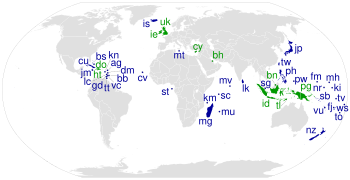
Back Eilandstaat Afrikaans Inselstaat ALS دولة جزرية Arabic دولة ݣزيرة ARY Ada ölkəsi Azerbaijani Inslstoot BAR Астраўная дзяржава Byelorussian Островна държава Bulgarian দ্বীপরাষ্ট্র Bengali/Bangla Ostrvska država BS

Countries/territories not shown on the map: Antarctica (aq) (continental disputed territory), Australia (au) (continental country), the Cook Islands (ck) (free association with New Zealand), Greenland (gl) (constituent country of the Kingdom of Denmark), Niue (nu) (free association with New Zealand), and Puerto Rico (pr) (unincorporated U.S. territory).
An island country, island state, or island nation is a country whose primary territory consists of one or more islands or parts of islands. Approximately 25% of all independent countries are island countries.[1] Island countries are historically more stable[1] than many continental states but are vulnerable to conquest by naval superpowers. Indonesia is the largest and most populated island country in the world.[2][3]
There are great variations between island country economies: they may rely mainly on extractive industries, such as mining, fishing and agriculture, and/or on services such as transit hubs, tourism, and financial services. Many islands have low-lying geographies and their economies and population centers develop along coast plains and ports; such states may be vulnerable to the effects of the climate, especially sea level changes.
Remote or significant islands and archipelagos that are not themselves sovereign are often known as dependencies or overseas territories.
- ^ a b Ott, Dan (1996). Small is Democratic. Routledge. p. 128. ISBN 0-8153-3910-0. Retrieved March 23, 2019.
- ^ Chepkemoi, Joyce (April 25, 2017). "Which Are The Island Countries Of The World?". WorldAtlas.com. Archived from the original on 2017-12-07. Retrieved 2019-08-10.
- ^ "Population, total 2015-2019". World Bank Open Data. Retrieved 21 April 2021.